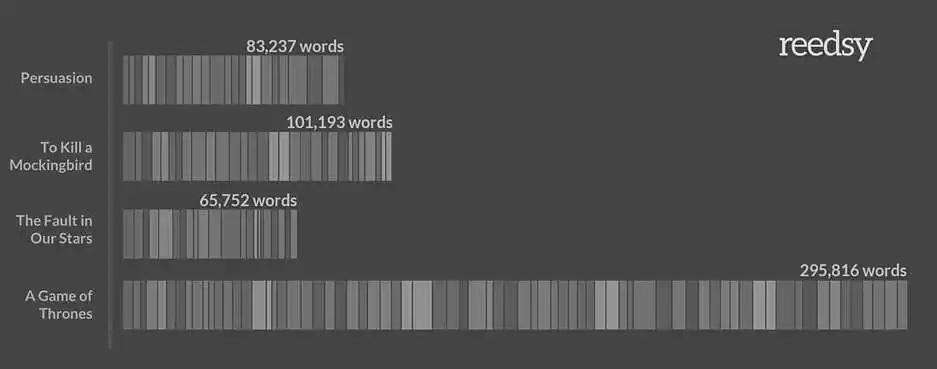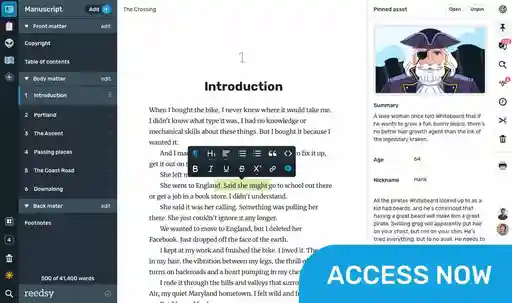Posted on May 29, 2025 11:14
How Long Should a Chapter Be? (Updated for 2025)
One of the first questions we hear the most from authors is how long their books should be. But what about chapter length?
Chapters are the building blocks of every book, and just like actual bricks, not all of them are equal. Some might be shorter. Others might be longer. So, what’s the sweet spot for an average chapter’s word count — and why in the world should that matter to you as an author? Let’s find out.
How long should a chapter be?
The average word count of a chapter generally ranges between 1,500 words to 5,000 words, with 3,000-4,000 words being the most common sweet spot.
To draw this conclusion, we analyzed 50 books from a wide variety of genres. Here’s a sample of what we found:

As you can see, chapter length varies, depending on the story.
- As Persuasion progresses, Jane Austen seems to elongate hers, building the chapters up on a crescendo.
- George R.R. Martin and Harper Lee keep things more evenly paced in A Game of Thrones and To Kill A Mockingbird, respectively.
- The chapters in The Fault In Our Stars, meanwhile, grow shorter just as Hazel's time with Augustus shortens.
What’s consistent across novels, however, is that they all tend to have an average chapter length of 2,000 to 5,000 words.
Does this mean that a chapter has to fall within this range? Of course not. Books with wildly divergent chapter lengths become bestsellers all the time. Think Kurt Vonnegut or Dan Brown on the shorter end of the spectrum — and J.R.R. Tolkien on the opposite end, for instance.
Ultimately, the way you section your book depends on the effect that you want to achieve at any given point in your novel, which brings us to the next question.
Why does the word count of a chapter matter?
Chapter breaks aren’t blocks of space that the writer just arbitrarily decided to insert. Instead, they help:
- Keep your readers in the story;
- Reset the story so that there’s no information overload. (Imagine watching all of The Lord of the Rings at once!);
- Adjust the pacing of the story and craft a feeling of suspense.
Knowing this, why does chapter length matter?
Imagine that you’re a conductor for a moment. If your story is a melody, its sections make up the underlying beat or rhythm. So the length of these affects the pacing of your story, and the way the reader experiences it:
- Do you want the pace to be brisk to the reader and skip in a staccato?
- Or do you want to keep your readers suspended on a whole note that carries on for some time?
A break also tells the reader to mentally prepare for some sort of shift. If your chapters are too short, however, you might not be able to build up any forward momentum.
Long chapters, on the opposite end of the spectrum, risk dropping the reader out of the story forever. That’s because a break between sections allows readers to take a quick breather in between words. If we made this one block of text go on for twenty pages or thirty pages on end, for instance, our best guess is that your eyes would glaze over and your skin would fall away and your fingernails would rot while you turn into The Skeleton With a Burning Cigarette, forcing yourself to continue reading a slab of text that just never seemed to stop. Or — worse still — you’d give up and put the text aside altogether.
Bottom of Form
How to end your chapters
So if you want your chapter breaks to pack a punch (whether it’s your first, second, or even fifth draft), here are a few of the ways you can frame the end of each section.Bottom of Form
1. The Promise
Broadly speaking, a chapter break does one of two things: look forward or look back. The former promises more intrigue in the next chapter, often by foreshadowing things to come. This is from the ending of Chapter 3 in The Hobbit:
The next morning was a midsummer’s morning as fair and fresh as could be dreamed: blue sky and never a cloud, and the sun dancing on the water. Now they rode away amid songs of farewell and good speed, with their hearts ready for more adventure, and with a knowledge of the road they must follow over the Misty Mountains to the land beyond.
— J.R.R. Tolkien, The Hobbit
This passage promises the reader plenty of upcoming adventure. Of course, its strategic placement at the end of the chapter also sets a reader’s irony senses tingling, telling them that things might not be all so bright and cheery for Bilbo and the gang soon.
2. The Resolution
Looking back on past events is another common way to end a chapter. This technique can simply bring the scene to a close, or it can be a way to summarize. In the exposition of Harry Potter and the Prisoner of Azkaban, J.K. Rowling re-familiarizes us with Harry Potter, an unusual boy wizard who misses some school friends. In this case, the conclusion nicely wraps up the themes and motifs she’s just introduced:
Deciding that he’d worry about the Hogsmeade form when he woke up, Harry got back into bed and reached up to cross off another day on the chart he’d made for himself, counting down the days left until his return to Hogwarts. Then he took off his glasses and lay down; eyes open, facing his three birthday cards.
Extremely unusual though he was, at that moment Harry Potter felt just like everyone else — glad, for the first time in his life, that it was his birthday.
— J.K. Rowling, Harry Potter and the Prisoner of Azkaban
Though it’s normally a bit of a cliché to close a chapter by getting the character to fall asleep, Rowling does a clever twist on it by making this an occasion worth describing.
Bottom of Form
3. The Cliffhanger
You bet we’ve all experienced our fair share of screaming matches with this sort of ending. Charles Dickens, whose serialized novels got readers in the 1800s coming back every week, was a master at writing cliffhangers — sometimes even in the middle of a fight.
Here is an example from Chapter 5 of Great Expectations:
But I ran no farther than the house door, for there I ran head-foremost into a party of soldiers with their muskets, one of whom held out a pair of handcuffs to me, saying, “Here you are, look sharp, come on!”
— Charles Dickens, Great Expectations
This time, the chapter ends mid-scene. In addition, this particular cliffhanger rests on a physical act — the soldiers approaching Pip. But it could just as well be a dawning mental or emotional realization that keeps readers on the edge of their seats. Whatever shape the cliffhanger takes, it’s the anticipation you generate that will keep your audience eagerly flipping those pages.
One caveat: you can only use this technique sparingly, or else it’ll start to grow repetitive and lose its impact.
4. The Era or POV Jump
If you’re writing a book that uses multiple perspectives or jumps time periods, the chapter break is an obvious opportunity to switch things up. One of the most prominent practitioners is George R.R. Martin’s A Song of Ice and Fire series, which cycles between a total of 31 characters. Rainbow Rowell’s Eleanor & Park also uses a break effectively to shift POVs:
Park couldn’t think of a way to get rid of her on the bus. Or a way to get rid of himself. So he put his headphones on before the girl sat down and turned the volume all the way up.
Thank God she didn’t try to talk to him.
— Rainbow Rowell, Eleanor & Park
Then the next section segues smoothly into Eleanor’s take on things, keeping readers intrigued by revealing a new angle on previous events. When there are more than two POV characters, you'll need to make sure that you distribute time equitably between them while making each character interesting in their own right, so that one 7,000-word chapter with a boring character doesn't slow the whole story down.
That said, there are always exceptions, which takes us to our next important point...
Guidelines, not rules
As with everything else when it comes to writing a book, these are only guidelines—not rules!
There are plenty of books that purposefully play with the word counts of their chapters. The Luminaries, which won the Man Booker Prize in 2015, has 12 sections that steadily decrease in word count to mirror the waning of the moon. (The first chapter of The Luminaries is 360 pages, whereas the final is two pages.)
Then there’s William Faulkner’s As I Lay Dying, in which Vardaman’s famous five-word sentence, “My mother is a fish,” is the whole of Chapter 19.
Or consider Fahrenheit 451, which contains a Part I and Part II — but no chapters.
So, don’t write a chapter with only one eye on your story and the other on your word count. When you're outlining your book and writing your first draft, focus on making the content of your story the best it can be. Then you can always circle back to adjust word counts afterward, with pacing and reader experience in mind.

